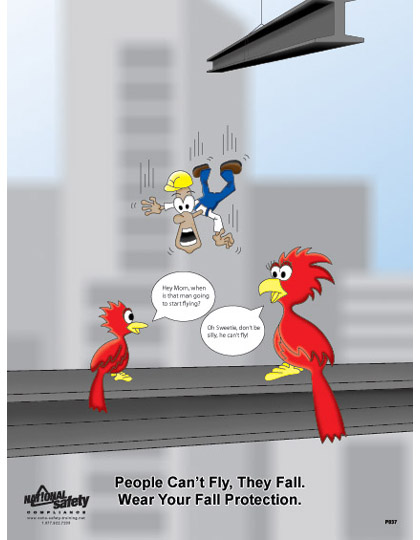Yesterday, we began a series about OSHA’s Top Ten List for violations and citations for fiscal year October 1, 2009 through September 30, 2010. Number One on the violations list was Scaffolding, Construction (29 CFR 1926.451). Topping the list for citations and coming in second for violations is Fall Protection, Construction (29 CFR 1926.501). Because construction is often done at elevated heights, the risk of injury and death from falling is greater than almost any industry in the United States. The Bureau of Labor Statistics reports that in a 7-year period, more than 4,500 American workers died as a result of falls. Many workers fall through existing openings in roofs, floors, skylights, temporary staircases, and off edges of roofs.
There are many examples of persons losing their lives because they were not using the proper safety equipment. One man was thrown from the bucket of a cherry picker when it was hit by a delivery truck. Two other men were in the bucket with him, but were wearing harnesses. Witnesses said he wasn’t even wearing a hardhat, let alone a harness. Another worker fell from the 10th floor of a hotel that was under construction. He was not wearing a harness, and climbed on the outside of a rail, despite being warned not to do so.
Contractors must identify all potential fall hazards in the workplace before work is to begin. Any time a worker is at a height of six feet or more, he is at risk and needs protection from falling. Some of the precautions to be taken are:
- Proper training of employees in the use of the safety system.
- Proper supervision of workers.
- Compliance with safe work procedures at all times.
- Selection of proper fall protection systems appropriate for each building site.
- Proper construction and installation of safety system.
- Being sure that everyone understands. Language barriers have been known to be at the root of many accidents.
As with any job, each worker is responsible for his own safety. Set an example by taking a few extra minutes to be sure that your safety equipment is going to work correctly. Wear your harnesses or other fall protection equipment! Others will follow suit, when they see that you are serious about safety.
Many persons are hurt by falling off ladders. It is important to choose the right ladder for the job. The ladder should extend three feet above the surface, and for every four feet in height of the ladder, the base should be one foot away from the wall. There are three types of ladders:
1) Type 1, which supports 250 lbs.
2) Type 1A, which supports 300 lbs.
3) Type 1AA, which supports 375 lbs.
Be sure to tie the ladder to fixed points – this will take about 5 minutes total for you to do at the beginning and end of the day, and could keep you safe. One other thing, when working on a ladder, don’t carry materials or tools while climbing the ladder. Use a tool belt, or install a rope and pulley system, or tie a rope around materials and pull them up when you reach the work surface.
Anyone who works in high places has my greatest admiration – I can’t even climb three feet off the ground! It is obvious that when the same violations occur year after year, it’s an indication that employers and employees are making the same mistakes every year about compliance with OSHA standards. This is a very serious threat to the safety and lives of thousands of construction workers. So, we are repeating for all those who are involved in working in high places: Fall Protection, Construction, (29CFR 1926.501) was #1 in highest penalties assessed by OSHA for fiscal year 2010, and #2 in Top Ten Violations, fiscal year 2010.
Source: OSHA, Centers for Disease Control and Prevention
